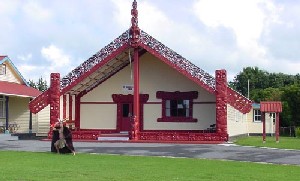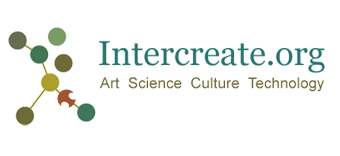
Photo: Historic Owae Marae, site of day one of the hui symposium
SCANZ 2013 3rd nature
developing the culture to create a sustainable civilisation
Themes
3rd nature involves creativity and innovation at the intersection of three critical interfaces:
*Acknowledging the environmental crisis
*Engaging with Maori and indigenous peoples
*Engaging with Sciences and the Hybrid Arts
These three intersecting dialogues provide space for a Third Nature, a fresh space for engaging with new knowledge and approaches vital to a sustainable civilisation.
Important dates
Residency dates: Arrive Friday 18 January 2013
We are asking residents to arrive in New Plymouth by Friday 18th January. This is to allow us to leave early on the 19th, for Parihaka. This marae was the location of an important passage of peaceful resistance led by Te Whiti and Tohu, leaders of the Parihaka community in the colonial period.
We are happy for people to arrive earlier. Some of the organisation team will go to Parihaka on the 18th, in accordance with protocol. The 18th of each month is a day in honour of Te Whiti and the 19th of each month is in honour of Tohu.
Flights to New Plymouth
There are only four or five flights per day to New Plymouth. If you land in the international terminal at Auckland you then need to take the free bus to the domestic terminal, or you can walk following a green line, which takes about ten minutes. Wellington also has a separate international terminal – I haven’t used it but imagine all processes are similar.
Air New Zealand is the only airline servicing New Plymouth (Nga Motu). Locate the Air New Zealand check in kiosks. Checking in is done by you at the kiosks, and there are staff to assist. You then drop your bags on to the conveyor (again someone assists). At Auckland Airport you then need to go to the regional airlines waiting area. Don’t be surprised to see large flight boards with no mention of New Plymouth flights. These are located in the area for departures and arrivals for the main centres.
The regional airlines departure area in Auckland is at the left end of the domestic terminal when standing outside and facing toward the doors. When your flight boards, you’ll walk quite a way to get to the plane, and the plane is quite small.
When your flights are arranged, please give the arrival and departure information to Thilani Nissanga. Thilani is our administrator. In the lead up to SCANZ she will be looking after arrival, departure and accommodation information. During SCANZ she will be staffing an admin office for queries, mainly during normal business hours, 9-4.30.
Car to New Plymouth
It takes around 5 hours to drive to New Plymouth, either from Auckland or Wellington. It depends on how long the breaks in the journey are and also how heavy traffic is. Some cars will no doubt be driving from Auckland around the 18th. For car pooling queries please contact Thilani. For those arriving internationally, we recommend the flight to New Plymouth. If you would like to go by car, we probably need to add an overnight stay (it is very tricky to arrange an incoming international flight arrival with a pick up in time to get to New Plymouth on the 18th), which means you would need to arrive at least a day earlier.
Residency dates: Check out Monday February 4th 2013
One of the reasons we say to check out Monday 4th February is that there are no late flights on Sunday night from New Plymouth. The last flight is around 7.15, so rather than rushing around on the final afternoon, it is simpler to leave the following day, checking out in the morning.
Symposium dates: February 1-3 2013
Arrive on January 31 2013
Day one of the hui symposium is at Owae Marae. We will be leaving early on Friday February 1st for the marae as there will be a powhiri when we get there. There is not really time to fly to New Plymouth and make it for the start of the powhiri. Anyone driving would need to leave Auckland or Wellington at 3.30am to make it for the powhiri.
Powhiri is the protocol of welcoming visitors onto a marae. The marae consists of a Whare Nui (Meeting House) and a Whare Kai (Eating House) plus a number of other buildings.
We will be called on to the marae, by women (wahine), one calling for the locals (tangata whenua), one for the visitors (manuhiri). At the threshold of the Whare Nui, there will be a hongi for some (pressed nose greeting where the breath is shared). Once inside, several people will speak – some for the tangata whenua, some for the manuhiri. After each speech, there is a song. The formal ceremony is concluded and then all are welcome to speak, in particular any women who may like to speak.
Owae Marae is progressive in that it is Ok for women to speak. Traditionally, women did not take part in this aspect of proceedings. So please take up this opportunity if you get the feeling to.
Presentations for day one should be those that do not require internet access, as we have had problems in the past with reliability. A projector will be available.
Exhibition opening: Dawn February 2 2013
Day two of the symposium starts with the dawn opening of the exhibition at Puke Ariki. We will have two vans to take people to the opening. Such openings are rare, even in Aotearoa New Zealand so everyone is encouraged to attend. We will have an extended mid morning break so everyone can freshen up.
The remainder of the day is at WITT.
The following day, Sunday starts at WITT and proceeds to Pukekura Park.
Depart on Monday 4th February preferred
While not strictly necessary, we encourage hui symposium attendees to leave on Monday. This allows some ‘slow down time’ after the events of the previous few days. It is also our intention, that those putting forward papers, are able to have their paper impacted by attendance at the hui. Consequently scheduling reflective time is advised. Making a few notes at the time makes paper editing and development that much quicker.
That said, it would be possible to leave by car around 4.30pm on Sunday and arrive in Auckland or Wellington around 9.30pm. Similarly flights from New Plymouth airport could be booked.








